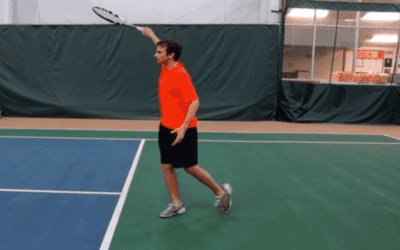The “Back To Front” Footwork
The return of serve footwork is a concept that many players ask me about in lessons and via email. Most players are told to just react to the serve and not worry about having the proper the return of serve footwork.
If you don’t learn the proper footwork, than you’ll be off balance on some returns especially on balls that stretch you. The last thing you want to do is to be thrown off when a big serve comes screaming at you.
Learning a very simple move on your return of serve footwork especially the wide serve will help you tremendously. You can use what I call the “Back to Front” footwork pattern.
You will see a lot of the pros use this footwork pattern on the return of serve.
Transfer The Weight Properly
To successfully use this movement pattern, you’ll come out of your split step and load the outside leg while making a good shoulder turn. As you push off the outside leg, you’ll be moving towards the ball and preparing to shift all the weight to the inside or front foot.
As you make contact with the ball, you’ll be pushing off the outside leg and most likely, both feet will be slightly off the ground as you transfer weight to the front foot.
Once you make contact, you will place the front foot down on the ground as your momentum carries out toward the doubles sideline as you handle the wide return.
After that, you want to swing the outside leg around so that you square up into a wide base before you start recovering back to the middle.
This is the most efficient return of serve footwork pattern to handle wide returns.



hi Ian,
What about Pete Sampras. I heard that he “snap’ or “flexion his wrist
Hi Dennis, No sure what you are asking about Sampras as this is a return of serve tip.
Hi Jeff! Great tip as usual. I really love watching your videos and picking up your tips. One thing I noticed in this video (which is kind of off topic) is that your student isn’t really split stepping like the pros do. He gets up well, but when he comes down, he lands on both feet at the same time rather than landing on his outside foot solely and pushing off from there. I think you actually made note in the serve and volley video that he lands very hard off his split; I think it might have to do with that he’s landing on both feet, which also slows him down a bit. Great video in all!
I agree, Jeremy. When playing, if you time the split properly, only one foot will hit the ground first.
Jeff-great video as always! Thank you! ! Quick question. While waiting to return Serve, Do you recommend that you should be in a forehand or backhand grip (I have a one handed backhand) thank you!
Thank you, Hondo! It really depends on if you can change the grip as the ball comes and what feels easier to you.
Many thanks for sharing your experience!
Excellent tip Jeff and thanks Jeremy for your comment. I thought that another point worth mentioning is that the returner’s movement during the return of serve for the wide serve is in a direction that is not parallel to the baseline but at an angle for maximum efficiency. This should happen naturally with the footwork discussed in this tip if the returner’s feet during the split step are also at an angle to the baseline.
Great work, Jeff. In the case of two righty players serving in the deuce court, I see serves go hard down the middle, curved into the body on the backhand, or swung out wide as you describe here. I rarely see anyone hit a flat serve out wide, toward the far corner of the serving box (or lightly to the right of that position). I DID see a woman pro use that serve effectively recently (Lucic-Baroni?). I have found this serve to be very effective in my much lower level of play against some pretty good former top college players. If you sense that a player might be anticipating a wide curved serve, and you hit him a flat one instead, he will often “jam” himself by over-reaching, or over-moving toward the ball. Try it yourself on those 30-30 points. It’s actually an easier shot to hit than the hard one down the middle….more margin for error…..Aim higher, though!